Sepiolite and Other Authigenic Mg-Clay Minerals Formation in Different Palustrine Environments (Madrid Basin, Spain)
Abstract
:1. Introduction
2. Geological Setting
3. Materials and Methods
3.1. Sampled Materials
3.2. Experimental Methodology
4. Results and Discussion
4.1. Description of Lithofacies in the Differentiated Units
4.2. Mineralogical Assemblages and Sedimentary Environment
4.2.1. Unit 1
4.2.2. Unit 2
4.2.3. Unit 3
4.2.4. Unit 4
4.3. Trace Elements and Source of Provenance
4.4. Genetic Considerations of Sepiolite and Associated Authigenic Mg-Clay Minerals
5. Conclusions
- Mineralogical analysis of lithofacies deposited in a lacustrine margin shows the relationship between palustrine conditions and the authigenic formation of magnesian clay minerals. Among the mud-flat deposits, two palustrine episodes originating from different hydrochemical conditions with concentrated and dilute water have been identified. The shift from one type of palustrine record to the other indicates an evolution towards freshening conditions in the basin, which is reflected in the lacustrine-palustrine context.
- In the mud-flat deposits, the presence of trioctahedral phases is interpreted as the formation of magnesian smectite of the saponite type, which would be the result of the transformation of Al-rich inherited minerals. The abundance of magnesium in the environment favoured the development of dolocretes in these deposits.
- In palustrine deposits with concentrated saline-alkaline water, the formation of sepiolite is favoured, which in a first phase would take advantage of supports with magnesian smectite (possibly stevensite) for its formation, followed by direct precipitation from solutions and/or gels (neoformation).
- In palustrine deposits with more dilute water, there are abundant carbonates where the existence of morphologies similar to seepage mounds indicate the active role of groundwater. Under these conditions, sepiolite and palygorskite form in thin beds inserted between the carbonates. The palygorskite would have formed as a result of the transformation of aluminous smectite into the fibrous clay mineral. Sepiolite in the absence of reactive aluminium would have formed by neoformation.
- The supply of silica is justified by the existence of a felsic source area of diorite-to-granite type, with geochemical characteristics that suggest the participation of two source areas that supplied the sediments in the studied area. Variations in the hydrochemical characteristics of the water in the lacustrine-palustrine environment were responsible for the authigenic mineral assemblages identified.
- The results obtained confirm that sepiolite can be formed in a wide range of salinity and pH, confirming the results reported in laboratory synthesis tests. It also corroborates that the formation of magnesian smectite (saponite) or palygorskite by transformation of inherited Al-smectite depends on the hydrochemistry of the water in the sedimentary environment.
Author Contributions
Funding
Data Availability Statement
Acknowledgments
Conflicts of Interest
References
- Millot, G. Geology of Clays; Springer: Berlin/Heidelberg, Germany, 1970. [Google Scholar]
- Jones, B.F. Clay mineral diagenesis in lacustrine sediments. U.S. Geol. Surv. Bull. 1986, 1578, 291–300. [Google Scholar]
- Galán, E.; Pozo, M. Palygorskite and sepiolite deposits in continental environments. Description, genetic patterns and sedimentary settings. In Developments in Palygorskite–Sepiolite Research. A New Outlook on These Nanomaterials. Developments in Clay Science; Galán, E., Singer, A., Eds.; Elsevier: Amsterdam, The Netherlands, 2011; pp. 125–173. [Google Scholar]
- Lasaga, A. Kinetic Theory in the Earth Sciences; Princenton University Press: Princeton, NJ, USA, 1998; pp. 1–811. [Google Scholar]
- Zhang, J.; Huang, F.; Lin, Z. Progress of nanocrystalline growth kinetics based on oriented attachment. Nanoscale 2010, 2, 18–34. [Google Scholar] [CrossRef] [PubMed]
- Deocampo, D.M.; Cuadros, J.; Wing-dudek, T.; Olives, J.; Amouric, M. Saline lake diagenesis as revealed by coupled mineralogy and geochemistry of multiple ultrafine clay phases: Pliocene Olduvai Gorge, Tanzania. Am. J. Sci. 2009, 309, 834–868. [Google Scholar] [CrossRef]
- Tosca, N. Geochemical pathways to Mg-silicate formation. In Magnesian Clays: Characterization, Origin and Applications; Pozo, M., Galán, E., Eds.; AIPEA Educational Series, Pub. No. 2; Digilabs: Bari, Italy, 2015; pp. 283–330. [Google Scholar]
- Guggenheim, S. Introduction to Mg-Rich clay minerals: Structure and composition. In Magnesian Clays: Characterization, Origin and Applications; Pozo, M., Galán, E., Eds.; AIPEA Educational Series, Pub. No. 2; Digilabs: Bari, Italy, 2015; pp. 1–62. [Google Scholar]
- Pozo, M.; Galán, E. (Eds.) Magnesian clay deposits: Mineralogy and origin. In Magnesian Clays: Characterization, Origin and Applications; AIPEA Educational Series, Pub. No. 2; Digilabs: Bari, Italy, 2015; pp. 175–228. [Google Scholar]
- Pozo, M.; Calvo, J.P. An Overview of Authigenic Magnesian Clays. Minerals 2018, 8, 520. [Google Scholar] [CrossRef] [Green Version]
- De Vicente, G.; Cloething, S.; Van Wees, J.D.; Cunha, P.P. Tectonic classification of Cenozoic Iberian foreland basins. Tectonophysics 2011, 502, 38–61. [Google Scholar] [CrossRef]
- Calvo, J.P.; Alonso-Zarza, A.M.; García del Cura, M.A. Models of Miocene marginal lacustrine sedimentation in response to varied depositional regimes and source areas in the Madrid Basin (central Spain). Palaeogeogr. Palaeoclimatol. Palaeoecol. 1989, 70, 199–214. [Google Scholar] [CrossRef]
- Calvo, J.P.; Jones, B.F.; Bustillo, M.; Fort, R.; Alonso-Zarza, A.M.; Kendall, C. Sedimentology and geochemistry of carbonates from lacustrine sequences in the Madrid Basin, Central Spain. Chem. Geol. 1995, 123, 173–191. [Google Scholar] [CrossRef] [Green Version]
- Pozo, M.; Casas, J. Distribucion y caracterizacion de litofacies en el yacimiento de arcillas magnesicas de Esquivias (Neogeno de la Cuenca de Madrid). Boletín Geológico Y Min. 1994, 106, 265–282. [Google Scholar]
- Galán, E.; Castillo, A. Sepiolite–Palygorskite in Spanish Tertiary Basins: Genetical Patterns in Continental Environments. In Palygorskite-Sepiolite. Occurrences, Genesis and Uses. Developments in Sedimentology; Singer, A., Galán, E., Eds.; Elsevier: Amsterdam, The Netherlands, 1984; pp. 87–124. [Google Scholar]
- Ordóñez, S.; Calvo, J.P.; García del Cura, M.A.; Alonso Zarza, A.M.; Hoyos, M. Sedimentology of sodium sulphate deposits and special clays from the Tertiary Madrid Basin (Spain). In Lacustrine Facies Analysis. Special Publications International Association of Sedimentologists; Anadón, P., Cabrera, L., Kelts, K., Eds.; Blackwell Scientific Publications: Oxford, UK, 1991; pp. 39–55. [Google Scholar]
- Pozo, M.; Calvo, J.P.; Pozo, E.; Moreno, A. Genetic constraints on crystallinity, thermal behaviour and surface area of sepiolite from the Cerro de los Batallones deposits (Madrid Basin, Spain). Appl. Clay Sci. 2014, 91–92, 30–45. [Google Scholar] [CrossRef]
- Schultz, L.G. Quantitative interpretation of mineralogical composition from X-ray and chemical data for the Pierre Shale. Geol. Surv. Prof. Pap. 1964, 391, 31. [Google Scholar]
- Van der Marel, H.W. Quantitative analysis of clay minerals and their admixtures. Contrib. Miner. Pet. 1966, 12, 96–138. [Google Scholar] [CrossRef]
- Chung, F.H. Quantitative Interpretation of X-ray Diffraction Patterns of Mixtures. I. Matrix-Flushing Method for Quantitative Multicomponent Analysis. J. Appl. Cryst. 1974, 7, 519–525. [Google Scholar] [CrossRef]
- Sánchez del Río, M.; Doménech, A.; Doménech-Carbó, M.T.; Vázquez de Agredos Pascual, M.L.; Suárez, M.; García-Romero, E. The Maya Blue Pigment. In Developments in Palygorskite–Sepiolite Research. A New Outlook on These Nanomaterials. Developments in Clay Science; Elsevier: Amsterdam, The Netherlands, 2011; pp. 453–481. [Google Scholar]
- Herranz, J.E.; Pozo, M. Authigenic Mg-Clay Minerals Formation in Lake Margin Deposits (the Cerro de los Batallones, Madrid Basin, Spain). Minerals 2018, 8, 418. [Google Scholar] [CrossRef] [Green Version]
- Pozo, M.; Casas, J.; Medina, J.; Calvo, J.P.; Silva, P.G. Caracterización de depósitos carbonáticos ligados a paleosurgencias en el sector de Batallones-Malcovadeso (Neógeno de la cuenca de Madrid). Estud. Geológicos 2006, 62, 73–88. [Google Scholar] [CrossRef]
- González, J.M.; Bauluz, B.; Fernández-Nieto, C.; Yuste, A. Factors controlling the trace-element distribution in fine-grained rocks: The Albian kaolinite-rich deposits of the Oliete Basin (NE Spain). Chem. Geol. 2005, 214, 1–19. [Google Scholar]
- McLennan, S.M.; Nance, W.B.; Taylor, S.R. Rare earth element-thorium correlations in sedimentary rocks, and the composition of the continental crust. Geochim. Cosmochim. Acta 1980, 44, 1833–1839. [Google Scholar] [CrossRef]
- Rollinson, H.R. Using Geochemical Data: Evaluation, Presentation, Interpretation; Pearson Education Limited: London, UK, 1993. [Google Scholar]
- McLennan, S.M.; Hemming, S.; McDaniel, D.K.; Hanson, G.N. Geochemical approaches to sedimentation, provenance, and tectonics. In Processes Controlling the Composition of Clastic Sediments; Johnsson, M.J., Basu, A., Eds.; Geological Society of America: Boulder, CO, USA, 1993. [Google Scholar]
- Condie, K.C. Chemical composition and evolution of the upper continental crust: Contrasting results from surface samples and shales. Chem. Geol. 1993, 104, 1–37. [Google Scholar] [CrossRef]
- Grizelj, A.; Tibljas, D.; Kovacic, M. Mineralogy and geochemistry of Upper Miocene pelitic sediments of the Zagorje Basin (Croatia): Implication for evolution of the Pannonian Basin. Geol. Carpathica 2007, 58, 263–276. [Google Scholar]
- Condie, K.C.; Wronkiewicz, D.J. The Cr/Th ratio in Precambrian pelites from the Kaapvaal Craton as an index of craton evolution. Earth Planet. Sci. Lett. 1990, 97, 256–267. [Google Scholar] [CrossRef]
- Pozo, M. Origin and evolution of magnesium clays in lacustrine environments: Sedimentology and geochemical pathways. In Proceedings of the First Latin-American Clay Conference, Invited Lectures, Funchal, Madeira, Portugal, 17–22 September 2000; Volume 1, pp. 117–133, ISBN: 972 98383 4 8. [Google Scholar]
- Calvo, J.P.; Pozo, M. Geology of magnesian clays in sedimentary and non-sedimentary environments. In Magnesian Clays: Characterization, Origin and Applications; Pozo, M., Galán, E., Eds.; AIPEA Educational Series, Pub. No. 2; Digilabs: Bari, Italy, 2015; pp. 123–174. [Google Scholar]
- Eberl, D.D.; Jones, B.F.; Khoury, H.N. Mixed-layer kerolite/stevensite from the Amargosa Desert, Nevada. Clays Clay Miner. 1982, 30, 321–326. [Google Scholar] [CrossRef]
- Khoury, H.N.; Eberl, D.D.; Jones, B.F. Origin of magnesium clays from the Amargosa Desert, Nevada. Clays Clay Miner. 1982, 30, 327–336. [Google Scholar] [CrossRef]
- Pozo, M.; Medina, J.A.; Leguey, S. Mineralogénesis de palygorskita en la zona central de la Cuenca de Madrid. Boletín De La Soc. Española Mineral. 1985, 8, 271–283. [Google Scholar]
- Pozo, M.; Casas, J.C. Origin of kerolite and associated Mg clays in palustrine– lacustrine environments. The Esquivias deposit (Neogene Madrid Basin, Spain). Clay Miner. 1999, 34, 395–418. [Google Scholar] [CrossRef]
- Tosca, N.J.; Masterson, A.L. Chemical controls on incipient Mg-silicate crystallization at 25 °C: Implications for early and late diagenesis. Clay Miner. 2014, 49, 165–194. [Google Scholar] [CrossRef] [Green Version]
- Clauer, N.; Fallick, A.E.; Galán, E.; Pozo, P.; Taylor, C. Varied crystallization conditions for neogene sepiolite and associated Mg-Clays from Madrid Basin (Spain) traced by oxygen and hidrogen isotope geochemistry. Geochim. Cosmochim. Acta 2012, 94, 181–198. [Google Scholar] [CrossRef]
- Jones, B.F.; Galán, E. Sepiolite and palygorskite. In Hydrous Phyllosilicates; Bailey, S.W., Ed.; Reviews in Mineralogy; Mineralogy Society of America: Chantilly, VA, USA, 1988; pp. 631–674. [Google Scholar]
- Deocampo, D.M. Evaporative evolution of surface waters and the role of aqueous CO2 in magnesium silicate precipitation: Lake Eyasi and Ngorongoro Crater, northern Tanzania. S. Afr. J. Geol. 2005, 108, 493–504. [Google Scholar] [CrossRef]
- Webster, C.E.; Jones, B.F. Paleoenvironmental implications of lacustrine clay minerals from the Double Lakes formation, southern High Plains, Texas. In Sedimentology and Geochemistry of Modern and Ancient Saline Lakes; Renaut, R.W., Last, W.L., Eds.; SPEM (Society for Sedimentary Geology): Tulsa, OK, USA, 1994; pp. 159–172. [Google Scholar]
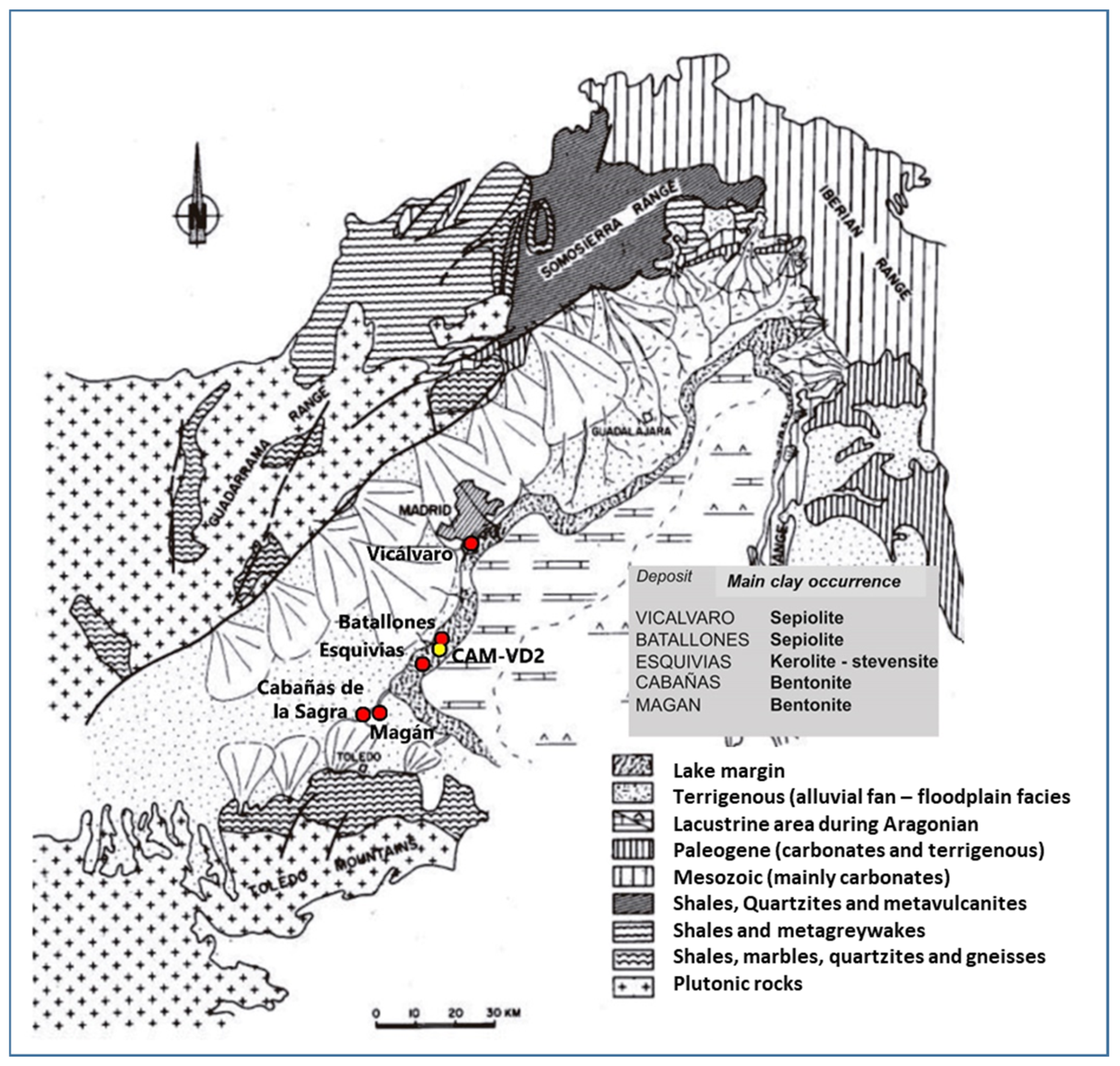

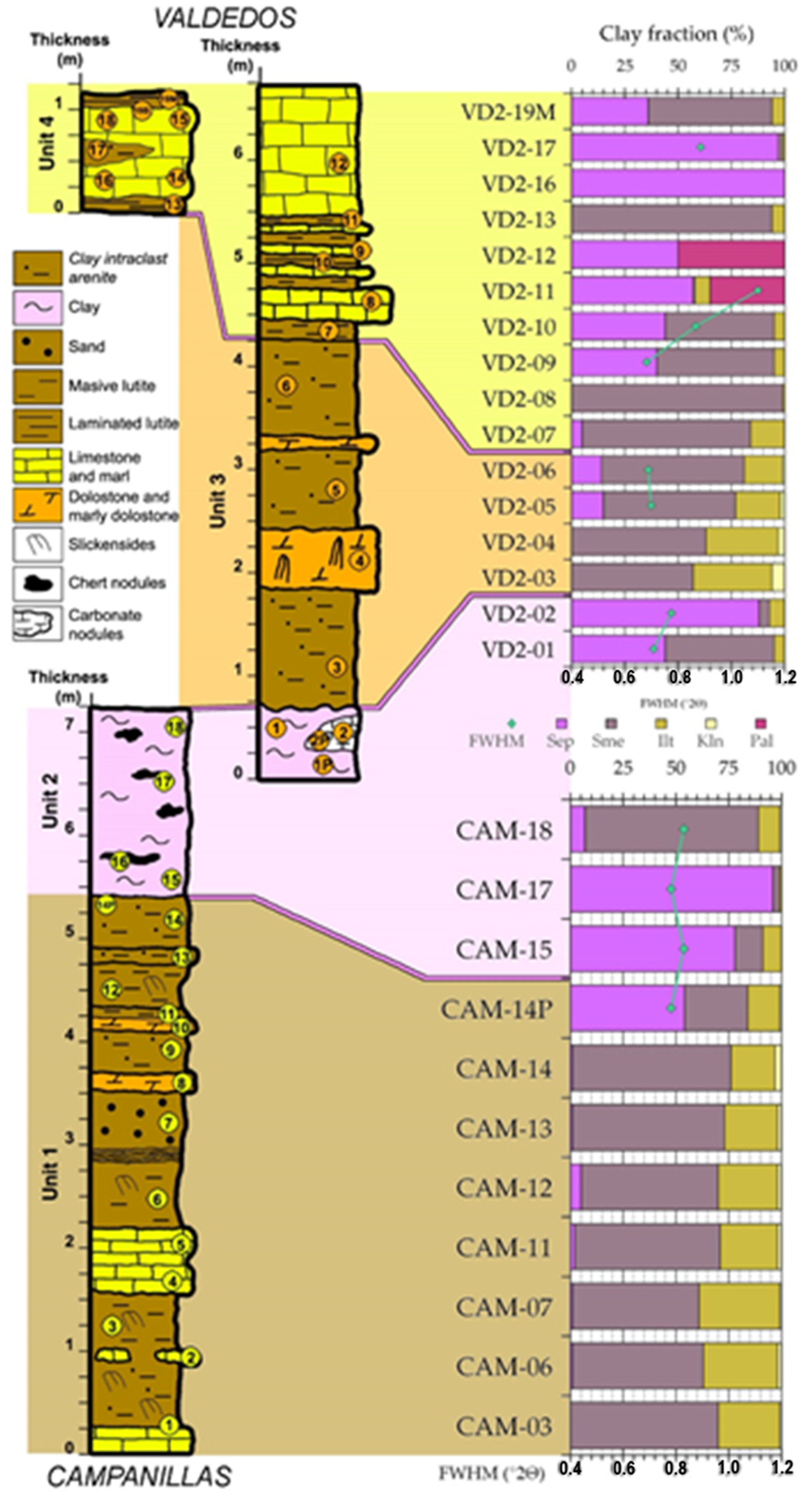
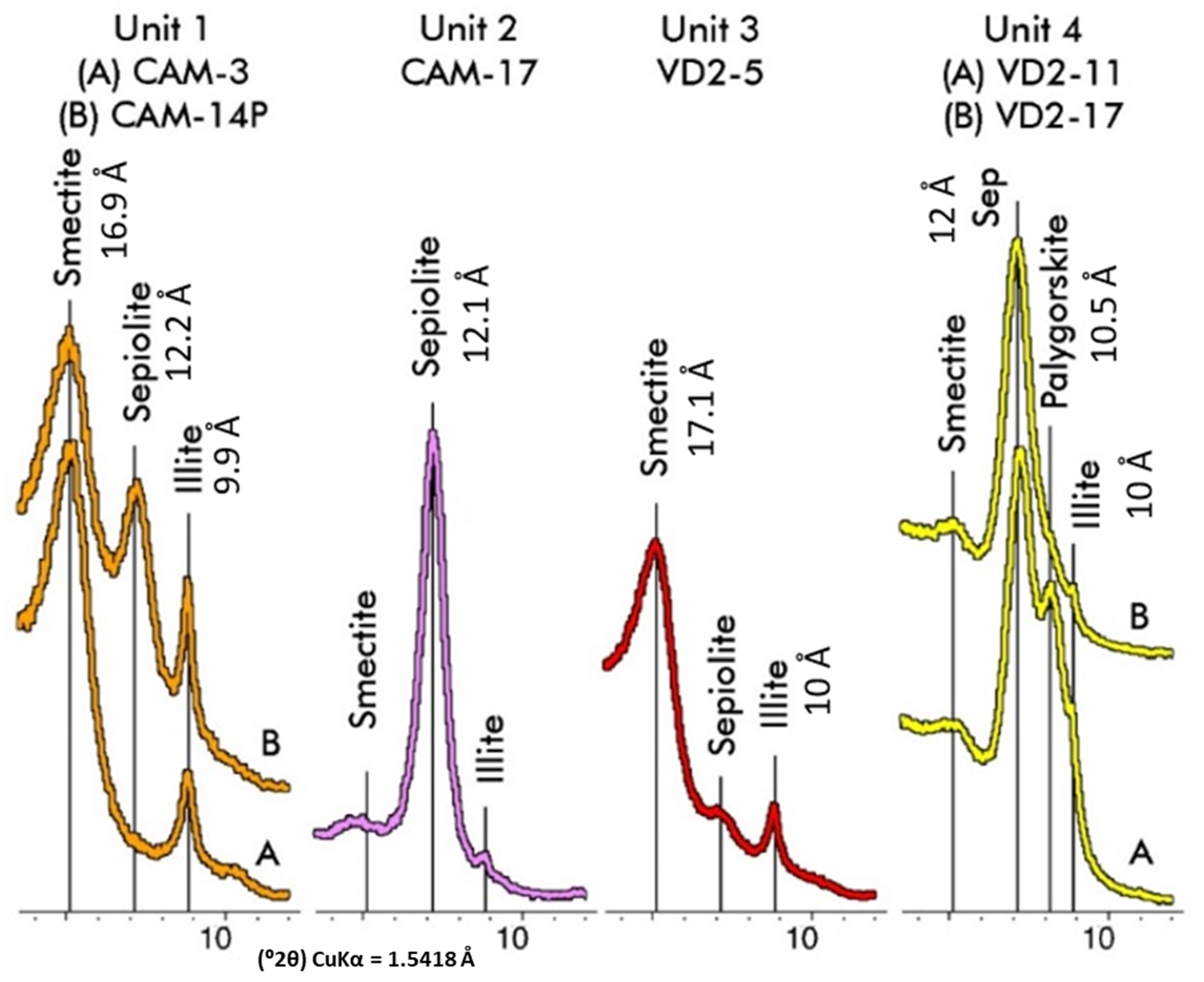
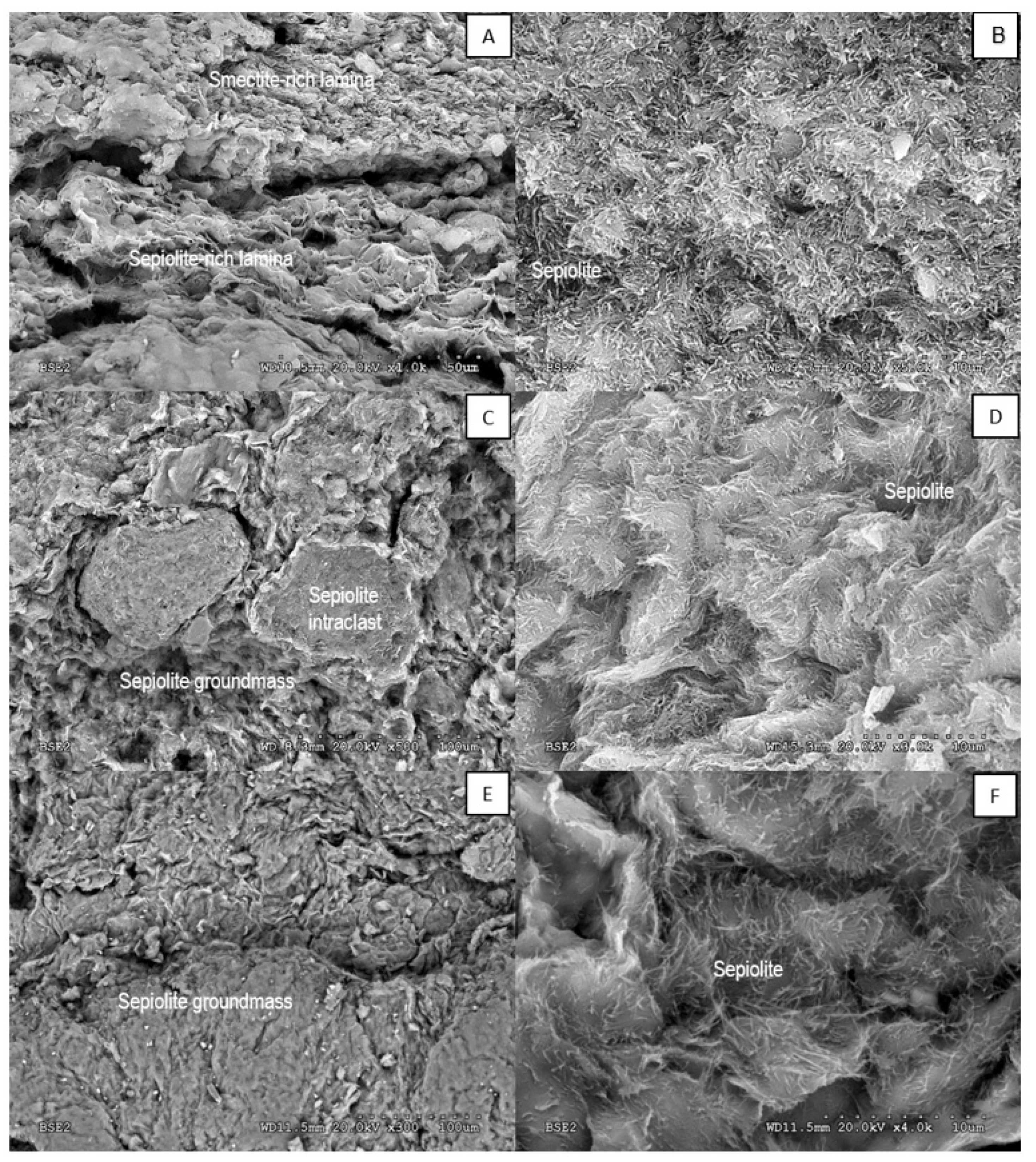
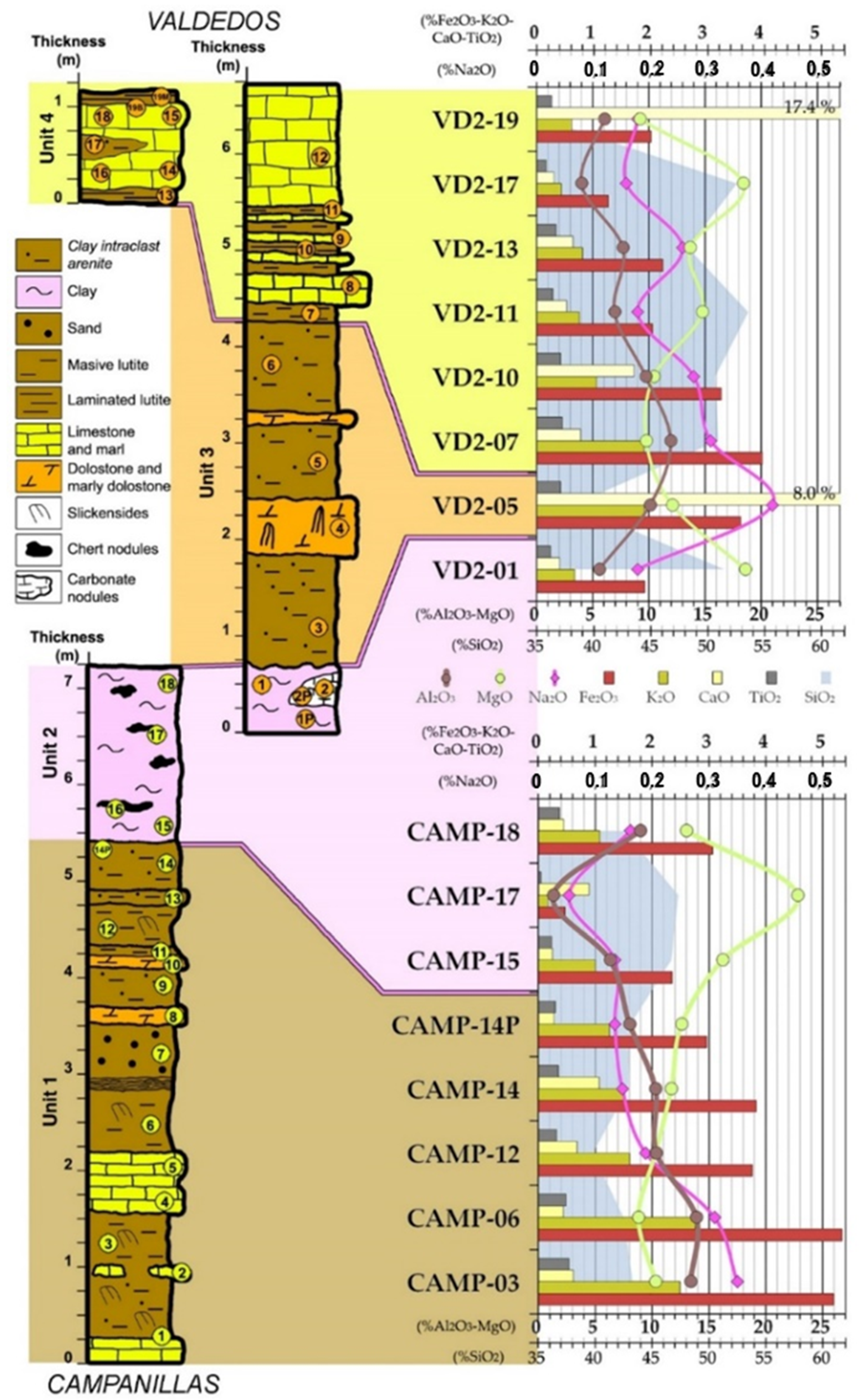
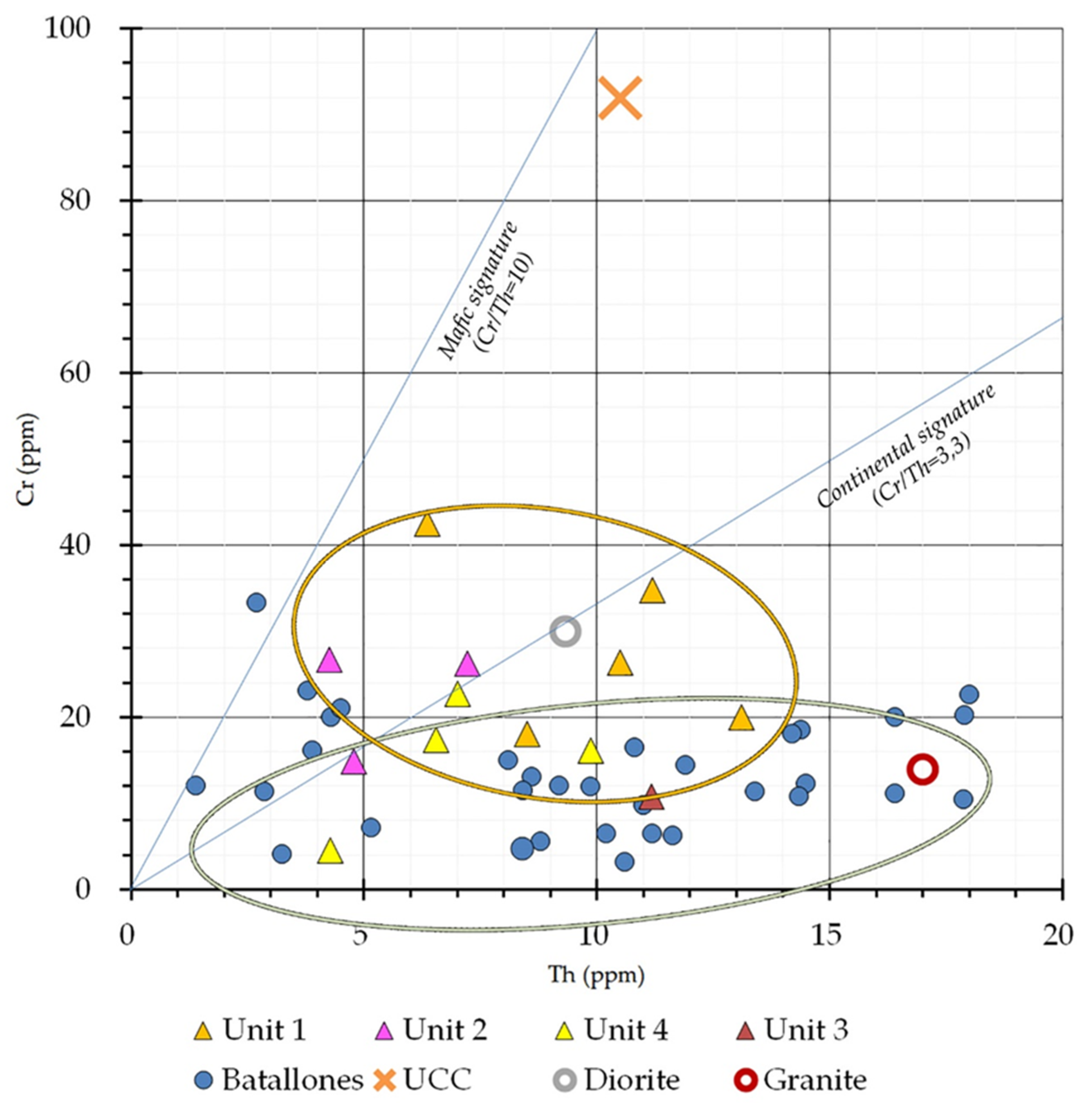

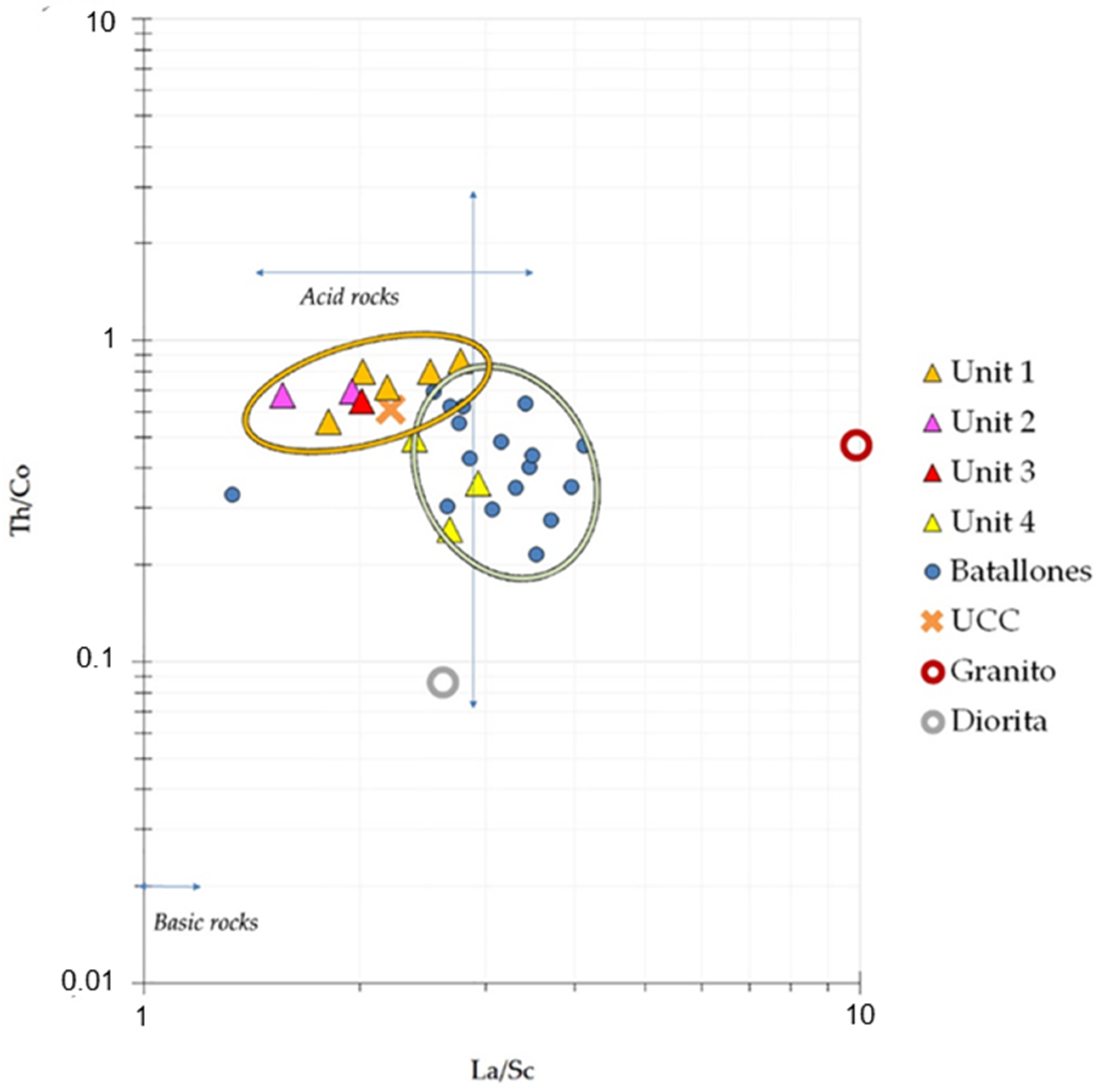

| Bulk Mineralogy (%) | Clay Fraction (%) | Sepiolite | |||||||||||
|---|---|---|---|---|---|---|---|---|---|---|---|---|---|
| Unit | Sample | Lithology | Phy | Qz | Fsp | Cal | Dol | Sme | Sep | Ilt | Pal | Kln | FWHM (°2Θ) |
| 4 | VD2-19M | Md | 81 | 4 | 10 | 5 | 57 | 35 | 6 | ||||
| 4 | VD2-19B | Lm | Tr | 100 | |||||||||
| 4 | VD2-18 | Lm | Tr | 100 | |||||||||
| 4 | VD2-17 | Md | 92 | 4 | 4 | Tr | 2 | 98 | Tr | 0.884 | |||
| 4 | VD2-16 | Lm | 11 | 89 | 100 | ||||||||
| 4 | VD2-15 | Lm | Tr | 100 | |||||||||
| 4 | VD2-14 | Lm | 8 | 92 | |||||||||
| 4 | VD2-13 | Md(l) | 86 | 8 | 6 | 94 | 6 | ||||||
| 4 | VD2-12 | Lm | 25 | 5 | 70 | 50 | Tr | 50 | |||||
| 4 | VD2-11 | Md | 92 | 4 | 4 | 1 | 57 | 7 | 35 | 1.100 | |||
| 4 | VD2-10 | Md(l) | 89 | 4 | 5 | 2 | Tr | 51 | 44 | 5 | 0.866 | ||
| 4 | VD2-09 | MaLm | 34 | 66 | 55 | 40 | 5 | 0.683 | |||||
| 4 | VD2-08 | Lm | 20 | 2 | 77 | Tr | 100 | Tr | |||||
| 3 | VD2-07 | Md | 93 | 4 | 3 | 79 | 5 | 16 | |||||
| 3 | VD2-06 | Md(i) | 90 | 4 | 6 | 67 | 14 | 18 | 1 | ||||
| 3 | VD2-05 | Md(i) | 92 | 3 | 5 | 63 | 15 | 21 | 2 | ||||
| 3 | VD2-04 | MaDo | 56 | 3 | 4 | 37 | 63 | 34 | 3 | ||||
| 3 | VD2-03 | Md | 94 | 5 | Tr | Tr | 57 | 37 | 6 | ||||
| 2 | VD2-02 | Md | 46 | 3 | 51 | 5 | 88 | 7 | 0.775 | ||||
| 2 | VD2-01 | Md | 89 | 6 | 5 | 52 | 44 | 5 | 0.708 | ||||
| 2 | VD2-01P | Nodule | 27 | 73 | Tr | 57 | 35 | 6 | |||||
| 2 | CAM-18 | Md | 100 | Tr | Tr | 82 | 7 | 10 | Tr | 0.830 | |||
| 2 | CAM-17 | Md | 95 | Tr | 4 | 1 | 3 | 96 | 1 | 0.781 | |||
| 2 | CAM-16 | Md | 100 | Tr | Tr | ||||||||
| 2 | CAM-15 | Md(l) | 100 | Tr | Tr | 13 | 78 | 9 | Tr | 0.830 | |||
| 2 | CAM-15C | Md | 100 | Tr | Tr | 2 | 96 | 2 | 0.749 | ||||
| 2 | CAM-15B | Md | 100 | Tr | Tr | 23 | 65 | 12 | Tr | 1.042 | |||
| 1 | CAM-14P | Md(l) | 100 | Tr | Tr | 31 | 54 | 15 | Tr | 0.782 | |||
| 1 | CAM-14Pa | Md | 100 | Tr | Tr | 20 | 72 | 8 | 0.739 | ||||
| 1 | CAM-14Pb | Md | 100 | Tr | Tr | 37 | 46 | 16 | 1 | 0.782 | |||
| 1 | CAM-14Pc | Md | 100 | Tr | Tr | 74 | 4 | 21 | 1 | ||||
| 1 | CAM-14 | Md(i) | 100 | Tr | Tr | 75 | Tr | 22 | 3 | ||||
| 1 | CAM-13 | Md(i) | 96 | Tr | Tr | 4 | 72 | 1 | 25 | 2 | |||
| 1 | CAM-12 | Md | 100 | Tr | Tr | 65 | 5 | 28 | 2 | ||||
| 1 | CAM-11 | Md | 100 | Tr | Tr | 69 | 2 | 27 | 2 | ||||
| 1 | CAM-10 | MaDo | 45 | 55 | |||||||||
| 1 | CAM-10B | Md | 81 | Tr | Tr | 19 | |||||||
| 1 | CAM-09 | SdDoMa | 58 | 15 | 4 | 23 | |||||||
| 1 | CAM-08 | SdDoMa | 22 | 3 | 27 | 48 | |||||||
| 1 | CAM-07 | Sd | 48 | 17 | 35 | 60 | Tr | 39 | 1 | ||||
| 1 | CAM-06 | Md | 93 | 4 | 3 | 62 | Tr | 36 | 2 | ||||
| 1 | CAM-05 | CaMa | 69 | 2 | 1 | 28 | |||||||
| 1 | CAM-04 | CaMa | 56 | 44 | |||||||||
| 1 | CAM-04B | Md | 75 | Tr | 25 | ||||||||
| 1 | CAM-03 | Md | 94 | 6 | Tr | 70 | 29 | 1 | |||||
| 1 | CAM-02 | Ma | 56 | 44 | |||||||||
| 1 | CAM-01 | Md(i) | 85 | Tr | 2 | 13 | |||||||
| Unit | Sample | Lithology | SiO2 | MgO | Al2O3 | Fe2O3 | CaO | TiO2 | K2O | MnO | P2O5 | Na2O | LOI |
|---|---|---|---|---|---|---|---|---|---|---|---|---|---|
| 4 | VD2-19 | Md | 35.71 | 9.22 | 6.04 | 2.04 | 17.44 | 0.27 | 0.62 | <0.05 | 0.17 | 0.18 | 26.82 |
| 4 | VD2-17 | Md(i) | 52.81 | 18.41 | 4.01 | 1.28 | 0.31 | 0.17 | 0.44 | <0.05 | 0.05 | 0.16 | 20.85 |
| 4 | VD2-13 | Md(l) | 48.46 | 13.68 | 7.70 | 2.25 | 0.65 | 0.35 | 0.82 | 0.05 | 0.05 | 0.26 | 25.33 |
| 4 | VD2-11 | Md | 53.83 | 14.76 | 6.95 | 2.07 | 0.54 | 0.29 | 0.76 | <0.05 | 0.24 | 0.18 | 18.89 |
| 4 | VD2-10 | Md(l) | 50.90 | 10.44 | 9.73 | 3.29 | 1.74 | 0.43 | 1.07 | <0.05 | 0.23 | 0.28 | 20.28 |
| 3 | VD2-07 | Md | 51.18 | 9.76 | 11.95 | 4.02 | 0.78 | 0.46 | 1.91 | <0.05 | 0.04 | 0.31 | 18.76 |
| 3 | VD2-05 | Md(i) | 38.30 | 12.08 | 10.13 | 3.63 | 8.01 | 0.43 | 1.92 | 0.05 | 0.08 | 0.42 | 24.06 |
| 2 | VD2-01 | Md | 51.68 | 18.58 | 5.60 | 1.93 | 0.41 | 0.25 | 0.68 | <0.05 | 0.04 | 0.18 | 19.14 |
| 2 | CAM-18 | Md | 47.60 | 13.00 | 8.98 | 3.07 | 0.45 | 0.37 | 1.08 | <0.05 | <0.05 | 0.16 | 25.50 |
| 2 | CAM-17 | Md | 52.30 | 22.80 | 1.33 | 0.47 | 0.89 | 0.05 | 0.17 | <0.05 | <0.05 | 0.05 | 21.90 |
| 2 | CAM-15 | Md(l) | 51.70 | 16.20 | 6.31 | 2.35 | 0.25 | 0.24 | 1.00 | <0.05 | <0.05 | 0.14 | 21.60 |
| 1 | CAM-14P | Md(l) | 48.10 | 12.60 | 8.05 | 2.96 | 0.28 | 0.30 | 1.25 | <0.05 | <0.05 | 0.14 | 25.60 |
| 1 | CAM-14 | Md(i) | 47.90 | 11.70 | 10.30 | 3.83 | 1.07 | 0.36 | 1.50 | <0.05 | 0.18 | 0.15 | 23.10 |
| 1 | CAM-12 | Md | 44.80 | 10.30 | 10.40 | 3.76 | 0.68 | 0.32 | 1.61 | <0.05 | 0.23 | 0.19 | 27.20 |
| 1 | CAM-06 | Md | 47.50 | 8.80 | 13.90 | 5.34 | 0.44 | 0.49 | 2.76 | <0.05 | 0.07 | 0.31 | 19.10 |
| 1 | CAM-03 | Md | 48.30 | 10.30 | 13.40 | 5.19 | 0.62 | 0.54 | 2.49 | 0.05 | 0.14 | 0.35 | 18.70 |
| Unit | Sample | Lithology | Co (2.41) | Cr (1.50) | La (5.08) | Th (1.5) | Sc (2.47) |
|---|---|---|---|---|---|---|---|
| 4 | VD2-19 | Md | <2.4 | 17.4 | 30.2 | 6.5 | 10.1 |
| 4 | VD2-17 | Md | 2.9 | 4.5 | 9.0 | 4.2 | <2.4 |
| 4 | VD2-13 | Md(l) | 4.8 | 16.1 | 17.4 | 9.8 | 7.3 |
| 4 | VD2-11 | Md | <2.4 | 22.7 | 15.4 | 7.0 | <2.4 |
| 4 | VD2-10 | Md(l) | 4.4 | 31.7 | 24.1 | 12.4 | 8.2 |
| 3 | VD2-07 | Md | 3.5 | 29.4 | 30.3 | 13.7 | 11.3 |
| 3 | VD2-05 | Md(i) | 7.2 | 10.7 | 26.4 | 11.1 | 13.0 |
| 2 | VD2-01 | Md | <2.4 | 14.8 | 10.9 | 4.7 | 5.1 |
| 2 | CAM-18 | Md | 4.8 | 26.2 | 15.0 | 7.2 | 9.6 |
| 2 | CAM-17 | Md | <2.4 | 1.8 | 3.0 | <1.5 | 2.1 |
| 2 | CAM-15 | Md(l) | 2.9 | 26.7 | 10.3 | 4.2 | 5.2 |
| 1 | CAM-14P | Md(l) | 3.5 | 42.5 | 13.1 | 6.3 | 7.2 |
| 1 | CAM-14 | Md(i) | 7.3 | 18.0 | 25.8 | 8.5 | 9.3 |
| 1 | CAM-12 | Md | 7.4 | 26.4 | 20.3 | 10.5 | 9.2 |
| 1 | CAM-06 | Md | 8.9 | 34.8 | 24.9 | 11.2 | 12.3 |
| 1 | CAM-03 | Md | 10.5 | 20.0 | 30.4 | 13.1 | 12.1 |
Publisher’s Note: MDPI stays neutral with regard to jurisdictional claims in published maps and institutional affiliations. |
© 2022 by the authors. Licensee MDPI, Basel, Switzerland. This article is an open access article distributed under the terms and conditions of the Creative Commons Attribution (CC BY) license (https://creativecommons.org/licenses/by/4.0/).
Share and Cite
Herranz, J.E.; Pozo, M. Sepiolite and Other Authigenic Mg-Clay Minerals Formation in Different Palustrine Environments (Madrid Basin, Spain). Minerals 2022, 12, 987. https://doi.org/10.3390/min12080987
Herranz JE, Pozo M. Sepiolite and Other Authigenic Mg-Clay Minerals Formation in Different Palustrine Environments (Madrid Basin, Spain). Minerals. 2022; 12(8):987. https://doi.org/10.3390/min12080987
Chicago/Turabian StyleHerranz, Juan Emilio, and Manuel Pozo. 2022. "Sepiolite and Other Authigenic Mg-Clay Minerals Formation in Different Palustrine Environments (Madrid Basin, Spain)" Minerals 12, no. 8: 987. https://doi.org/10.3390/min12080987
APA StyleHerranz, J. E., & Pozo, M. (2022). Sepiolite and Other Authigenic Mg-Clay Minerals Formation in Different Palustrine Environments (Madrid Basin, Spain). Minerals, 12(8), 987. https://doi.org/10.3390/min12080987







